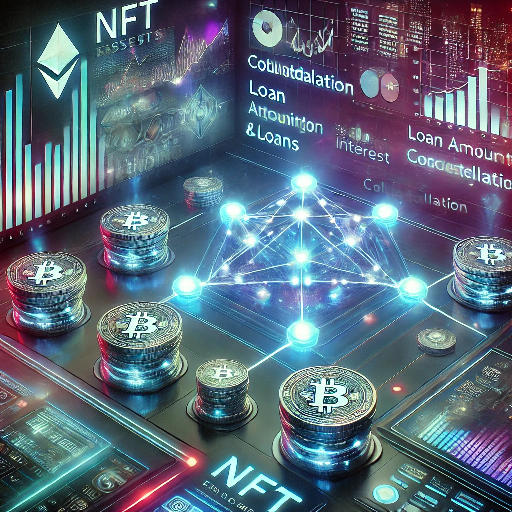Introduction of NFT Lending and Collateralization
NFT Lending and Collateralization is revolutionizing the digital asset landscape by enabling liquidity for non-fungible tokens (NFTs). As the NFT market matures, many investors seek ways to leverage their assets beyond mere ownership. With NFT Lending and Collateralization, users can unlock capital without selling their valuable digital collectibles.
Understanding NFT Lending and Collateralization
NFT Lending and Collateralization refers to the process of using NFTs as collateral for obtaining loans. This model allows NFT holders to leverage their assets for liquidity while retaining ownership. Borrowers pledge NFTs as security for loans, and lenders provide funds based on the perceived value of these digital assets.
How NFT Lending Works
The process of NFT Lending and Collateralization typically involves the following steps:
- Asset Evaluation: The borrower selects an NFT to use as collateral, and its value is assessed based on factors such as rarity, demand, and historical price trends.
- Loan Terms Negotiation: The lender and borrower agree on loan terms, including interest rates, repayment periods, and liquidation conditions.
- Smart Contract Execution: A smart contract governs the agreement, ensuring that both parties adhere to the loan terms and facilitating secure, automated transactions.
- Loan Disbursement: The lender provides funds to the borrower, who retains conditional ownership of the NFT.
- Repayment or Liquidation: If the borrower repays the loan, they reclaim full ownership of their NFT. If they default, the lender may liquidate the NFT to recover their funds.
The Benefits of NFT Lending and Collateralization
Unlocking Liquidity
NFT Lending and Collateralization enables NFT owners to access funds without selling their assets. This is particularly beneficial for collectors who believe their NFTs will appreciate in value.
Expanding Investment Opportunities
Investors who lack capital to purchase high-value NFTs can borrow against their existing assets, allowing them to participate in new market opportunities without liquidating holdings.
Increased Utility for NFTs
NFTs often remain dormant in wallets, serving as digital collectibles with limited use. NFT Lending and Collateralization enhances their functionality by transforming them into financial instruments.
Trustless Transactions with Smart Contracts
Blockchain-based lending platforms utilize smart contracts, which reduce counterparty risk and ensure transparent, enforceable agreements without intermediaries.
Challenges in NFT Lending and Collateralization
Valuation Difficulties
Unlike traditional assets, NFT prices fluctuate significantly, making it challenging to determine accurate collateral values. Standardized valuation mechanisms are still evolving.
Market Volatility
NFT markets can be highly volatile, impacting the stability of NFT Lending and Collateralization agreements. Sudden price drops may trigger liquidations, causing potential losses for borrowers.
Legal and Regulatory Concerns
The regulatory landscape for NFT Lending and Collateralization is still developing. Unclear legal frameworks may pose risks for lenders and borrowers alike.
Risk of Default
Lenders face potential losses if borrowers default on loans, especially in cases where collateral values decrease below loan amounts.
Leading NFT Lending Platforms
Several platforms are pioneering NFT Lending and Collateralization services, including:
- NFTfi: A peer-to-peer lending platform enabling users to borrow and lend against NFTs.
- Arcade: Focuses on NFT-backed loans for high-value digital assets.
- BendDAO: Allows instant borrowing against blue-chip NFTs with an innovative liquidity pool model.
- Pine: A decentralized finance (DeFi) protocol supporting NFT-backed lending and borrowing.
Future Trends in NFT Lending and Collateralization
Institutional Adoption
As NFT Lending and Collateralization matures, institutional investors may enter the space, bringing increased liquidity and credibility to the market.
Cross-Chain Lending Solutions
Interoperability between blockchains could enhance NFT collateralization by enabling seamless lending across different ecosystems.
Tokenization of NFT Loans
Fractionalized lending models may allow multiple investors to collectively fund NFT-backed loans, diversifying risk and expanding market participation.
Integration with Traditional Finance
Hybrid financial models may emerge, allowing traditional banks to explore NFT Lending and Collateralization as a novel asset class.
Conclusion of NFT Lending and Collateralization
NFT Lending and Collateralization is reshaping the way digital assets are utilized in the financial landscape. By enabling liquidity without requiring sales, this model empowers NFT owners to maximize their asset value. Despite challenges like valuation uncertainties and regulatory concerns, the future of NFT Lending and Collateralization appears promising, with continuous innovations enhancing accessibility and market stability.

















